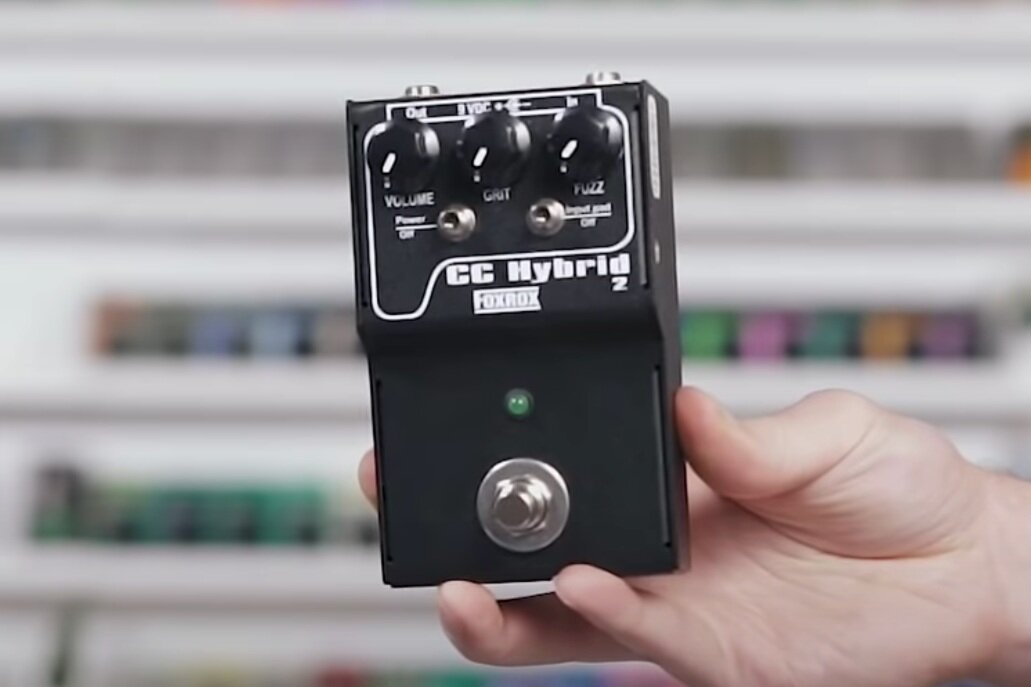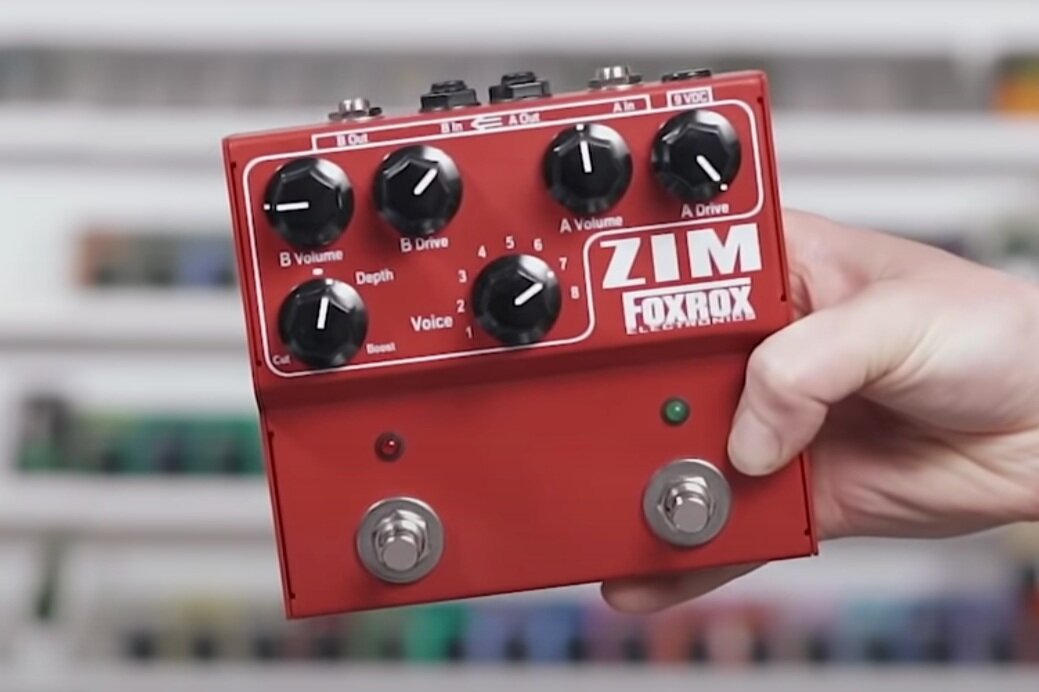Foxrox Electronics Run Down
Who Is Dave Fox?
In this article, I'm going to teach you about a company that I love called Foxrox and the man behind it: Dave Fox. He’s a myth, a man, and a legend. Dave Fox has been working in electronics and making pedals for a long freakin’ time. He’s a hero to me in this industry because of the amazing circuits that he's developed over the years.
I asked him if I could call him and learn a bit about how he got started, and he graciously obliged. Here’s what he said:
“I went to the Institute of Audio Research in 1983 and ’84. And when I was there, I wasn't really into being a recording engineer after about six months of [classes], but I was really into circuit maintenance, working in a studio. So I took some extra courses in that [field], and actually went to the Institute a few extra months after I graduated to take some more courses. That led to me getting a job at Crest Audio through their job placement in the Fall of ’84. [I got the position as] a QC technician for their new line of mixing boards.”
Now, years later, Dave is repairing a mixer and he needs some parts. So he goes back to the warehouse to find them and stumbles into a gold mine. This is the equivalent of a cat burglar breaking into a house and finding the safe already open. This is also the discovery that launched Dave into the pedal industry. I’ll let Dave pick up the story from here:
“I was working on a mixing console and I needed to go get some parts from the warehouse. I found some shelves with all these old parts, and there were a couple of fuzz faces and boxes full of trem faces. So I grabbed one of those fuzz faces, [and went to] the demo room where you could set up an amp. I brought in my amp and my guitar, and I plugged into the fuzz face, and it sounded awful. It was a dud. I had two or three [fuzz faces] there, and they all sounded awful. They barely passed the signal.”
“I remember thinking, wow, Hendrix must have been really good to get a sound like this out of a fuzz face. How did he sound [so good] while I sound [so bad]? So, I was messing around with it. Around the same time, there was an article in Guitar Player Magazine by Craig Anderson about the technology of the fuzz face that gave me a little bit of background. I didn't have any internet, so I was reading about it. [That’s how] I came up with the idea of making [fuzz faces] again. It seemed like a cool idea. I went to the president of the company, John Lee, and told him what I wanted to do. And he said, ‘Yeah, go ahead and get started.’”
The mid-’80s Crest fuzz faces came in two colors, gray and red, and contained the BC109 chip. This is a really cool piece of guitar history to have in your pedal collection. Eventually, Crest stopped backing fuzz faces, but in 1992 Dave started his own pedal brand, which he called Foxrox. That’s where this story really takes off.
The original pedals that Dave built in the early nineties are part of the very first lineage of boutique pedals, in the same camp as early Fulltone, Way Huge, the Klon Centaur, pedals like that. These vintage fuzz faces are super cool, but they’re also extremely hard to find. For simplicity’s sake, I'm only going to focus on the modern versions of Foxrox pedals, the gear that you can go buy right now from his website.
Foxrox CC Hybrid2 Fuzz
CC Hybrid2 Fuzz
The CC Hybrid2 Fuzz is Dave’s take on what a good fuzz face should sound like. It first debuted as one of his very early pedals called the Captain Coconut. That's what CC stands for. And you know what's really cool about this? It’s the first ever produced hybrid transistor fuzz face, meaning there's not two germanium transistors or two silicones transistors. It actually has one of each kind, which makes it really stable. This pedal is very tuneable, and an all-around fantastic fuzz pedal. It carries on that lineage from his days at Crest.
What I like most about the CC Hybrid2 is its ability to not go nuts. I know that may sound a little strange when I’m describing a fuzz, but there is such a thing as understated distortion and it can really work if you use it right. In this case, you can have some nice overdriven, mid-gain fuzz tones that don’t overwhelm the entire mix.
Octron 2 & Octron 3
One of my favorite Foxrox pedals is the Octron, which I own in the second and third versions. Technically, there's also a first version out there somewhere, but I don't have that, so we aren’t going to talk about it. The main difference between the Octron 2 and the Octron 3 is size and feature set on stomp switches. The Octron 2 has three foot switches: octave up, direct (meaning clean signal), and octave down. It also features a bypass button. With the Octron 3, you just have one foot switch setting, so you’d want to put your knobs where you want them with octave up, octave down, and direct. Basically, the Octron 3 is really simple, and the Octron 2 is a little more user-friendly in a live scenario.
Now the “octave up” feature is technically a take on the Tycobrahe Octavia Octave Fuzz, but it's not really like the Octavia at all. It's an op-amp version of an Octavia, which is really cool and original. The “octave down” setting is inspired by the DOD Octoplus FX35 Octave. I’ll be honest, if you already know about both of these pedals, then you're in a secret club of cool people who like cool pedals. Fight Club without the actual fighting, in other words.
Foxrox Octron 2
Foxrox Octron 3
Zim Dual Drive & Mini Zim
I am a huge fan of the Foxrox Zim, both the Zim Dual Drive and the Mini Zim. So much so that we had to plan a second live show just to talk about these two pedals.
That said, I’ll give the broad strokes here. The Zim Dual Drive looks fairly simple, but then there's the Mini Zim. Basically, if you put two Mini Zims together, then you get the Zim Dual Drive. But the real magic happens when you take the back off of the Zim Mini. There's a little screw here that, when unscrewed, allows you to pull out the main circuit and replace it with any of Dave’s other circuits. These circuits are incredibly cheap, like twenty or thirty bucks apiece. You can even trade your old ones back into him.
Basically, the Mini Zim is a modularly perfect pedal, which has never been done before. No big deal.
Foxrox Zim Dual Drive
Foxrox Mini Zim
Foxrox 2 Boost
2 Boost
The next pedal on the list is a brand new Foxrox pedal: the 2 Boost. Essentially, it’s a boost pedal with a boost control, which also has a top switch so you can engage a second boost.
Now, here’s where it gets really wild. The 2 Boost is actually a phase shift tuneable boost. So instead of normal tone control, he's actually using a phase shift circuit to navigate the frequency. It's wild. It's really wild. I've never seen anything like this. My favorite way to set it up is as a low-fi, very cool, flabby treble booster.
I can’t put it any more clearly than that, you guys.
Foxrox FR 100 Overdrive
FR 100 Overdrive
The FR 100 Overdrive is the MVP of Foxrox’s pedal line, mainly because the form factor is so small and it has a really versatile control set. That’s what you call a win-win. So you have the overdrive on the foot switch, and then you have the control knobs at the top of the enclosure.
Now, I’m going to share some specs on this pedal that might divide the room a little: this pedal has the clipping section of a Tube Screamer. And I say that cautiously, because I can hear people's thoughts. “Oh, another Tube Screamer. Lame.” Yes and no -- by which I mean, yes, it’s a Tube Screamer clipping section, but no, it’s far from lame. It’s actually really cool. This clipping section gives the pedal a totally different feeling to me, and then you can engage a lead channel, which is super useful and way better than most traditional Tube Screamer formats.
This pedal also has features similar to a FullDrive. Now, we're all familiar with the Fulldrive, but I've honestly never been a fan. Basically, when you hit the boost, there's not a lot of volume, and depending on the setting it might not sound different at all. The FR 100 Overdrive does not do that. You can tell a difference when this mode is on, and it’s very, very cool. Honestly, I could see this being the only drive pedal on your pedal board. It’s that good.
Hot Silicon & AquaVibe
Let's talk about the AquaVibe. So, when Dave started Foxrox in 1992, the very first thing he ever built was called a ProVibe. The ProVibe was his rendition and replication of an original Univibe, which back then and in the present day can be really hard to find. And like a lot of vintage pedals, even if you got your hands on an original Univibe, there was a 90% chance it would be broken. So Dave took the third option and got into making his ProVibe pedals instead, and it became pretty popular. The AquaVibe is simply that same concept -- a really solid UniVibe pedal in a modern enclosure -- but retooled for 2020.
The AquaVibe has a great enclosure size and it sounds fantastic. Honestly, though, one of the best things about his version of this circuit is the center control. This is usually an internal tremor that's fragile, finicky, hard to handle, but Dave takes that control and puts it on the outside instead. Genius. He binds the parameters of the controls to a useful range and makes it that much easier for the guitarist to play with it. I love it. It also changes that point at which the Univibe “thumps,” when it goes over in the waveform comes back down.
The Hot Silicon is a truly pure silicon fuzz. It’s a slightly hotter tone that features more gain and more fuzz because of the silicon transistors. You can compare this to the CC Hybrid2 Fuzz that we mentioned earlier; the main difference is that the CC Hybrid2 Fuzz uses both germanium and silicon transistors.
Foxrox Hot Silicon
Foxrox AquaVibe
Honestly, you can’t go wrong with any of the pedals on this list. They’re all freakin’ amazing. Dave Fox is a really, really fantastic designer. He takes the same approach to pro audio building mixers and desks for people when he builds a guitar pedal. Dave has worked on huge front of house rigs for massive tours and A-level bands, and he's done it for decades and decades. You can really tell when you open these pedals that the way they're built and the way that they function is high quality.
Dave is also responsible for pushing the boutique pedal movement forward, and is directly responsible for guitar pedal companies like JHS even existing. He broke a lot of barriers and opened doors for tons of pedal makers that came after him, and I'm incredibly thankful for that.
Go buy a Foxrox pedal. You won’t regret it.









